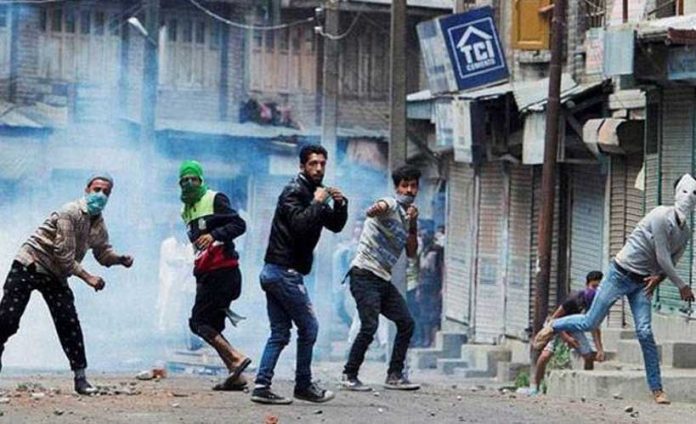A group of envoys visited the illegally-occupied Jammu and Kashmir State ostensibly to get a first-hand account of the situation in Jammu and Kashmir and government’s efforts to restore normalcy. Srinagar welcomed the envoys with a spontaneous shutdown. Prior to the visit, political leaders and human-rights activists were detained. The envoys did not visit Farooq Abdullah, Mehbooba Mufti or any of the other opposition Kashmiri leaders.
The Hindu of February 17 reported ‘The J&K government showcased “deepening democracy” to visiting 24 foreign diplomats, who arrived on a two-day tour of the Union Territory (UT) on Wednesday amid a spontaneous shutdown in Srinagar and alleged detention of recently elected National Conference (NC) district council members in Budgam’.
After abrogation of the special status, India took a number of steps to silence public dissent, including diurnal and nocturnal search operations to hound, kidnap or kill the Kashmiri people, an Internet shutdown, and blatant use of draconian laws against ordinary Kashmiris and their leaders alike. A law was passed to jail parents of stone-pelters., if any. Meanwhile local body elections were held in which the ruling BJP was cut to size. But, India, as reported by The Hindu also, showcased the elections in international media as a proof of popular participation and contentment of the people with the status quo.
The mysterious silence in the Valley during the envoys’ visit speaks volumes on how much the Kashmiris hate India. However, it appears the Kashmiris could have shown their ennui through some mode of peaceful protest. They could draw lessons from the Occupy the Wall Street Movement in the USA.
Occupy has six letters. A group of six persons mostly celebrities in their fields, stand up at some busy street holding letters O,C, C, U, P, and Y. The Kashmiris also could have displayed the letters in the word `AZADI’ through a group of five persons.
Arnold Toynbee, in his Challenge and Response Theory postulates that if a challenge is too onerous a nation may become apathetic. In similar vein, Ibn-e-Khaldun suggests that survival of a tribe (nation) depends on cohesion (asabiya, nationalism) of a tribe faced with life-and-death threat around its frontiers.
Toynbee’s Challenge and Response Theory suggests that if the challenge is too strong, a nation becomes apathetic. Ibn-e-Khaldoon’s asabiya (spirit of national cohesion) also suggests that a nation’s spirit is likely to be smothered by a challenge which is too heavy. Historical lessons do not apply to the Kashmiris struggle. Neither the Dogra nor the Indians could gag them. The struggle for freedom has continued unabated.
Amy Chua (Political Tribes: Group Instinct and the Fate of Nations) talks about the static or dynamic response of a society as shaped by group instincts of various components of a society.
Chua challenges the view that the conventional mechanism of demokratia (government by the people) is a panacea for all the problems of a society. Thus the recently-held local level elections or even `state assembly’ elections in occupied Kashmir are no panacea for the Kashmiris’ simmering discontentment, their revulsion to yoke of Indian rule. Chua, in her afore-quoted book analysed situations in Vietnam, Afghanistan, Iraq and Venezuela, besides so-called terror tribes, including the Islamic State of Iraq and Syria.
Chua’s framework would suggest it is naïve to believe that Kashmiris are resigned to their fate. By analogy, even a thousand years of exploitation by a microscopic Chinese population did not subdue the Vietnamese hatred of the Chinese. As soon as the Americans left Vietnam, the native Vietnamese preyed upon the rich Chinese community like a pack of wolves. The Americans plunged into a decade-long futile war with Vietnam without realizing that the Vietnamese were not Chinese stooges.
Indian forces had been using pellet guns to blind the Kashmir. Now, according to former chief minister Mehbooba Mufti, they have begun to use even chemical weapons against the Kashmiris.
Let us have a glimpse of the Dogra regime’s reign of terror in Kashmir. To stifle the Kashmiris’ fighting spirit, the regime punished even Kashmiri children who played with slingshots (ghulail) and stones. Under the Dogra rule, the Kashmiris were treated no better than beasts of burden. Instead of donkeys and horses, Kashmiri Muslims were used to transport goods across Gilgit, Leh and Skardu. They carried luggage on their backs across glaciers as high as 17,000 feet. Thousands of them perished along the way each year owing to frostbite, falls from precipices, and hunger or sickness. The Dogra caravans were not humane enough to stop for a while in the snowy passes to look after the injured porters (or ‘human beasts of burden’). Besides performing the forced labour, the Kashmiri had to pay heavy taxes. The whole of their produce was confiscated by the Dogra. Little was left for tillers and their children to eat. On every item, the oppressed Kashmiri had to pay multiple taxes. Take shawls. Not only the shawl-makers were taxed, but also the other intermediaries like importers of pashmina (wool) from Ladakh, and storekeepers, whether wholesalers or retailers.
The regressive revenue system resulted in a famine during winter of 1877. People began to die of starvation. Instead of releasing grain stocks from the royal godowns, the maharajah’s constabulary drowned the starved, crying people in the Wullar Lake. A historian writes: “Whole boatloads of starving people have been conveyed by the Maharajah’s officials to the Woolar Lake, and there drowned.”
The reign of terror by Indian forces (now estimated at about 900,000 regulars and security personnel), who replaced the maharajah’s constabulary on 27 October 1947, is no less gruesome. International human-rights organisations, as well as India’s National Human Rights Commission, have brought into limelight the Kashmiris’ mysterious disappearances, their custodial deaths, and countless rapes of hapless Kashmiri women.
Like the Dogra, Indian rulers are mercilessly exploiting Kashmiris’ economic resources. The bulk of the electricity generated there is being diverted to Indian states. The tourism industry is in shambles. Highly-educated people have no jobs. With no inflow of tourists, the shopkeepers have no business. Unlike the occupied Kashmir, all the socio-economic sectors in Azad Kashmir are progressing by leaps and bounds.
Toynbee’s Challenge and Response Theory suggests that if the challenge is too strong, a nation becomes apathetic. Ibn-e-Khaldoon’s asabiya (spirit of national cohesion) also suggests that a nation’s spirit is likely to be smothered by a challenge which is too heavy. Historical lessons do not apply to the Kashmiris struggle. Neither the Dogra nor the Indians could gag them. The struggle for freedom has continued unabated.
The lesson from Kashmiris’ struggle for freedom is that repression or palliatives like elections in occupied Kashmir are no good. The Kashmiri wants “freedom”. Their group instinct is `resistance’. But they need to learn from peaceful resistance movements like Occupy.























Writer needs to learn meaning of freedom from Bengali Muslims in earstwhile ‘East Pakistan’. 😏